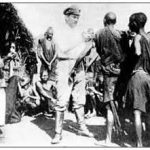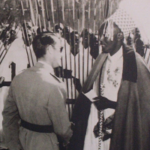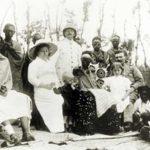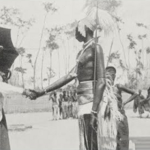Concepts And Paradigms
As noted, experienee in the field shifted the focus of inquiry, and brought four concepts into the foreground of this concern: ethnicity, clientship, labor control practices, and state formation. To illustrate the significance of these four elements in contrast to their underemphasis in the existing theoretical Iiterature, I shah review the concepts one by one, indicating why they were neglected or distorted. Ingeneral this survey will suggest that the major flaws in the existing conceptual frameworks can be attributed to their ahistorical character, their failure to view ethnicity, clientship, labor control practices, and statebuilding in terms of historical transformations. Associated with this has been atendency to privilege the perspective of Rwandan elites. As I have indicated, the empirical research for this study spans almost a century, from approximately 1860 to 1960. Thus it takes into account developments within major Rwandan historical epochs that have been consistently overlooked. The analysis here suggests that the way to correct flaws in the existing models is to take a detailed historical look at how institutions and relationships evolved in the context of a changing state.
Ethnicity
Although the terms “Hutu” and “Tutsi” are probably very old in Rwandan social discourse, there is evidence that the meanings attached to these categories and the political significance of membership in them changed significantly over time. In Kinyaga, before the introduction of central Rwandan rule toward the end of the nineteenth century, identification as “Hutu” appears to have had little political importance. Since Hutu/Tuutsi categorizations are today such essential components to ideology and conceptualization of Rwandan social relations, relevant data from within Rwanda are scarce on this point. But indications from neighboring areas not controlled by the Rwandan state are suggestive. just to the west of Kinyaga, on Ijwi Island (now part of Zaïre), an area with which Kinyagans maintained intensive but informal contacts and with which there had once been considerable population mobility from Rwanda, “Hutu” and “Tuutsi” are not relevant social categories (except as they relate to immigrants who came to the island after 1960). Despite these longstanding contacts, however, and despite their intimate knowledge of other aspects of Rwandan society, most people on Ijwi do not know of or do not clearly understand the term Hutu. On Ijwi all Rwandans are referred to collectively as “Badusi” (derived from the Ikinyarwanda term Abatuutsi), but individually a Rwandan is identified by his clan—”Mudaha,” “Musinga,” etc. This is often more significant in terms of identity than are current ethnie terms “Hutu” and “Tuutsi.”
Moreover, in the accounts of Kinyagan informants, the status of “Tuutsi” is often viewed not merely as a function of descent, but as dependent on the control of wealth (particularly in cattle) and power. The data in this study strongly imply that before political factors made the labels of “Hutu” and “Tuutsi” meaningful and necessary in Kinyaga, social identification belonged principally to the unit that performed corporate political functions—in this case, the lineage or neighborhood residential group. The introduction to Kinyaga of central Rwandan administrative structures during the reign of Rwabugiri (1860-1895) brought contact with political institutions and social distinctions at a new level, and it was under these conditions that current ethnic identifications became salient.
With the arrival of Rwabugiri and his chiefs, classification into the category of Hutu or Tuutsi tended to become rigidified. Lineages that were wealthy in cattle and had links to powerful chiefs were regarded as Tuutsi; lineages lacking these characteristics were relegated to non-Tuutsi status. During the period of Tuutsi ruIe, later overlaid by European rule, the advantages of being Tuutsi and the disadvantages of being Hutu increased enormously. In this context there occurred a gradual enlargement to scale of “ethnic” awareness among Hutu through realization of common oppression.
For three reasons, the term caste—winch in any event bears the connotations of rigid hierarchy and immutability—will not be used in this study. First, there existed no religious ideology sanctioning separation between ethnic groups in Rwanda. Second, economic specialization between the groups was not so clear-cut as has sometimes been thought. For example, both Hutu and Tuutsi engaged in activities a
sociated with the care of cattle (since Tuutsi cattleowners often put their cattle in the charge of Hutu herders), and cattle were esteemed by both groups. The major differences between Hutu and Tuutsi in control over cattle could be reduced to control over political power—this then becomes a criterion of political and legal, but not economic, differentiation. Third, the categories Hutu and Tuutsi were in the past relatively flexible; social mobility and “passing” from one category to another did occur (though opportunities for mobility out of the Hutu category apparently diminished in the later colonial period). Such flexibility is attested by the Kinyaga data; it is indicated for Rwanda in general by written sources from the interwar period. In 1922, for example, Father Léon Classe (a missionary with many years of experience in Rwanda) wrote:
It should be noted that the term “Tuutsi” often refers not to origin (descent) but to social condition, or wealth, especially as regards cattle: whoever is a chief, or who is rich will often be referred to as Tuutsi. Frequently also, because of their manner or their language,… the inhabitants of the provinces of Central Rwanda, Nduga and Marangara, as well as those of Buganza are referred to as Tuutsi.
As Classe suggests, there was a tendency to associate the appellation “Tuutsi” with possession of wealth and power, and particularly with wealthy powerful persons coming from central Rwanda. Those who were wealthy and powerful were likely to be regarded as Tuutsi, so that the category came to be in some respects self-defined as an elite. Moreover, a person’s “ethnic” status was not immutable; it could change. As Louis de Lacger pointed out in his history of Rwanda (published in 1939):
Tutsi and Hutu are words which tend to lose their especially racial meanings and become no more than qualifiers, accepted discourse, -within which are included capitalists and workers, rulers and ruled, without bringing seriously into play the question of birth. . . . A “petit mututsi” lacking the means of satisfying the monetary demands of providing wives for his offspring is obliged to fail back on the peasant world. He obtains wives from families of peasant status and if the condition of his family is prolonged, if his sons and grandsons are forced to resign themselves to the same type of indigence, his family will see itself gradually eliminated from the society of “the right kind” of people; it will descend to the level of the rural mass. The inverse is no less frequent. A muhutu capable of providing his father-in-law with a cow will be able to obtain a wife from a median level Tuutsi family; with time and a growing prosperity his offspring would come to be considered as descendants of a “good” family.
The conviction that Hutu and Tuutsi groups constituted “castes” resulted in the neglect of significant variations over time in both the degree of stratification between Hutu and Tuutsi and the factors conditioning such variation. Considering the development of the terms Hutu and Tuutsi historically and empirically provides a foundation for criticizing the conceptualization of these terms found in much of the theoretical literature. Such an analysis also prompts a reassessment of two major theories about ethnic politics that have oriented much of the writing about eihnicity in the third world. These include the primordialist perspective, associated with modernization and political development approaches of the 1950s and 1960s, and the instrumentalist perspective, which modified primordialist concepts in important ways. These theories are inadequate, however, because they do not take into account the complexity of ethnic interaction that the above sketch of the terms Hutu and Tuutsi indicates.
The modernization and political development analytic frameworks (on which the primordialist perspective was based) clearly distinguished between what were seen as “traditional” features of society and “modern” features. “Traditional” societies were conceived of as relatively stade and undifferentiated, consisting of groups defined by ascriptive, parochial identities; “traditional” features of society were therefore associated with “internal” factors, and stasis. “Modern” features, on the other hand, tended to be equated with change and with extemal factors such as colonialism or other forms of contact (willing or unwilling) with the “modern” West.
Traditional cultural elements were thus seen as opposed to modern elements. In particular, traditional identities, it was believed, posed a threat to the development of modern politics (especially the development of loyalties to a modern nation-state) because of their “primordial” character and parochial concerns. According to the political development literature of the 1950s and 1960s, over the long term modernization would result in the dissolution, and eventual transcendence, of such primordial identifies. However, in the short run (a vague, unspecified period describing a category within which would be included most of the third world today), changes associated with modernization
were expected to exacerbate conflicts between groups whose basis had been defined by primordial, ascriptive, loyalties.
If one adopts a view that stresses the “primordial” ethnic or “tribal” basis of political activity, Men solidarity based on cultural affinities tends to be assumed, rather than seen as a phenomenon to be explained. From such a perspective ethnic groupings are generally portrayed as having existed before the political interaction between the groups so defined. In analyses of conflicts between ethnic groups, this often led to a focus on ancient cultural differences, rather than specific issues that divide and define groups, as the primary source of conflict.
This book takes a different perspective. It argues that to understand the politics of ethnicity one must study the changing context within which ethnic interaction occurs. The following chapters concentrate not on ethnicity per se, but rather on changes in state power that transformed relations between groups, created new forms of cleavages, and fostered new forms of solidarity. Such analysis indicates that far from being “primordial,” ethnic solidarities in Rwanda were engendered in large part by transformations within the political system itself. Of course, cultural affinities can serve as an important basis for building cohesion and collaboration. And there do (and did) exist cultural differences between Tuutsi, Hutu, and Twa in Rwanda. Yet the definition of group boundaries and the recognition of cultural affinities as a basis for solidarity could, and did, change over time, as did the mobilization of ethnic identity (to be differentiated from regional solidarities) to further political purposes. Like all relative categories they were conditioned by the larger context of political activity. To capture this processual aspect of politioal identity, a diachronic approach to studying ethnicity is adopted here. This approach examines the changing socio-economic and political environment in which group interaction occurred. It focuses on how individuals and groups (elites as well as non-elites) attempted to shape change. And it shows how these interrelated processes have molded patterns of social cleavage and conflict in the state.
The processual approach ta ethnicity to be articulated later in this book shares certain elements with the “instrumentalist” perspective on ethnicity. Over the past two decades many studies af ethnicity in Africa and elsewhere have demonstrated the often subjective, relative nature of ethnic identifies and their potentially elastic and situational qualities. In building on these findings, a number of scholars have recognized that it is essential to understand the dynamic aspects of ethnicity in order to explain how and why ethnic identifies become mobilized into politics—and to account for their potential and their limitations in this process. Such studies, labeled “instrumentalist,” view ethnic groups “less as ‘primordial groups’ emerging into consciousness than as cultural categories transformed into self -conscious communities by leaders, elite groups, or the state and seeking to provide social, economic, and political advantages for the groups in question. Instnunentalist studies retain from earlier theories of political development and modernization a primary focus on the impact of “modernization,” but provide more specific insights than did the earlier theories as to how social, political, and economic changes may alter relations between groups.
In particular, instrumentalist studies emphasize that modernization creates new forms of competition over scarce resources. It is precisely this competition that is instrumental in the crystallization of ethnic identities, giving rise to new or transfomed “ethnic” groupings. Within this fluid political context, so the major thrust of this form of analysis goes, such groups gain self-awareness (become “self-conscious communities”) largely as the result of the activities of leaders who mobilize ethnic followings in order to compete more effectively. Improved communications and the spread of writing are important in this process; so is “ethnic learning,” where groups develop ethnic awareness as a result of seeing others using ethnic solidarities to compete. The state is important, instrumentalists suggest, as an arena in which competition between these groups occurs (the state controls many of the scarce resources over which elites are competing), and also because government policies can significantly affect the strategies chosen by ethnic leaders.
Instrumentalist studies that focus primarily on leaders and their role -within the state arena usually fail to explain the role of followers in this process of crystallizing ethnic identities: Why do the followers follow? Do they, in tact, follow? Despite their advances on modernization theories in certain respects, some of these instrumentalist studies still portray rural people as essentially quiescent until mobilized by elites. The elites, then, are seen as the major forces in the creation of ethnic consciousness—or at least in the political mobilization of ethnic identities. In this respect such studies appear to retain and expand the basic concepts of modernization theories even while accepting the fluidity of ethnic identities. They do not examine, empirically and at the local level, the role that rural populations have played in these dynamic, essentially dialectic processes of ethnic identity formation and political activity.
Like instrumentalist analyses, this book emphasizes the importance of structural changes—changes in the political, economic, and social context within which group interaction occurs—as an essential means to understanding ethnicity as a political factor. But unlike many of the instrumentalist studies, the approach adopted here attempts to provide a “view from below.” Looking beyond the more narrow focus of many instrumentalist studies on competition among elites for resources at the level of the formal state political arena, this study highlights the wider ramifications of changes that affected non-elites. It focuses particularly on shifts in the powers of chiefs, and on exploitation: The growing powers of chiefs transformed patron–client relationships and led to more exploitative forms of control over land and labor. In general, modernization theories tend to ignore exploitation because they view social change as a more or less neutral process. Similarly, instrumentalist analyses, in their concentration on leaders and competition, often fail to account for perceived exploitation as a factor in the mobilization of ethnic identities.
Statebuilding, Patron–Client Politics, and Labor Control
If ethnicsolidarity is to be seen as a variable, a social phenomenon to be explained rather than a preexisting immutable given, then to understand the preconditions of the Rwandan Revolution we need to shift the focus away from a concentration on ethnic factors to examine the processes of class formation that underlay perceived ethnic stratification. For such study it is necessary to “unpack” the concept of the state” and examine at close hand the changing character of relation-ships between state power, subjects/citizens, and ideology.
The growth of state power in Rwanda translated into increasing control by Tuutsi authorities over resources that could permit individuals and groups to improve their material condition (or prevent their material condition from deteriorating).” Particularly in the colonial period, politics very clearly involved a process of attempting to “gain control over public resources for private ends. And the state served not just as an arena for competition, but also as an active agent creating, maintaining, and attempting to justify patterns of ethnic inequality.” Political centralization and changes in land tenure arrangements under colonial rule thus altered class relations and created new forms of social cleavage. Patron–client ties were a key element in these changes. A study of how such clientship relations were transformed in the context of the evolving colonial state is essential to understanding the extent and impact of Tuutsi power.
Patron–client ties are often seen as inhibiting the development of horizontal solidarities among lower-class groups; they provide vertical linkages between powerful political actors and individual, less powerful individual clients.” In studies of Rwanda, ubuhake cattle clientship was often described as performing such an integrative role. The analysis here will propose, on the basis of empirical data from Kinyaga, that clientship does not necessarily promote social integration; it can—and in Kinyaga it did—promote social cleavage. It is essential that the political significance of clientship be assessed in terms of the larger historical and political context. Clientship in Rwanda was not a static social “given”; it was a dynamic phenomenon. Forms of clientship changed over time.
Patron–client ties can best be assessecl in terms of the power relations holding between the parties involved. A concept of clientship is needed that will reflect the potentially dynamic character of such relationships. I view clientship as a form of “instrumental friendship” between two persons of relatively unequal socioeconomic status. The relationship usually involves the exchange of protection and/or benefits from the person of higher status [the patron) for general loyalty and service from the lower-status person (the client). But the degree of reciprocity in the relationship may increase or decrease over time, and the exchanges between the partners may vary from rather fixed and defined duties to diffuse and ad hoc demands. In Rwanda, patron–client ties sometimes linked a client who represented a group such as a kinship or local residential unit to a patron.
The direction of change in clientship forms in Rwanda tended to be unidirectional, toward less reciprocity and more exploitation. These transformations were related especially to the growth of state power and changes in the social relations of production. Growth in the power of the state (expressed particularly through political centralization and growing government penetration at the local level) placed increased prerogatives in the hands of Tuutsi authorities, who used these powers to enhance their control over key resources: land, cattle, and people. In the context of the colonial economy, control over people became particularly important in the mobilization of labor —for private accumulation (as in the growing enichment of chiefs) and “public” projects, such as roadbuilding. The development of labor control mechanisms was thus intimately linked both to transformations in clientship and
to expansion of state power. These interactive processes reflected the economic underpinnings to state policies; they also indicated the key role of state power in processesof accumulation.
Thus, in colonial Rwanda, patron–client ties tended to become highly coercive. Reciprocity declined as exploitation intensified. In precolonial Rwanda, patron–client ties did not link all of Rwandan society together and contribute to some static “equilibrium.” Instead, far from being static, they were changing in the precolonial period, and they expanded rapidly within the power context of colonial rule. Political relations between patrons who were Tuutsi and those of their clients, who were Hutu, were exclusionist, so that over time clientship tended to sharpen lines of social differentiation. These and other transformations associated with the growth of state power and the expansion of capitalism were critical in the development of political consciousness among rural dwellers and in the configuration and political salience of ethnicity in Rwanda.
The structure of the argument advanced in this book reflects the conceptual concerns discussed above. The three chapters in part I describe the development of state power in Rwanda and its imposition in Kinyaga, providing a dynamic view of the political context which influenced changes in clientship and rural class relations. Thus, chapter 2 outlines conditions in Kinyaga during the eighteenth and nineteenth centuries, when political penetration by the central court was quite limited and the local population enjoyed considerable autonomy. Chapter 3 explains how this autonomy was eroded and Tuutsi/Hutu distinctions deepened with the expansion of state power under Rwabugiri. These expanding structures of state power were then further transformed during the period of European colonial rule. As Europeans dictated changes in state structures and attempted to bureaucratize the roles of chiefs, Tuutsi factions at the central court and regional elites in Kinyaga each jockeyed to gain benefits from the evolving statebuilding process.
Chiefs who were willing to collaborate with the Europeans saw their power and wealth enhanced; in return, they were expected to impose heavy demands on their people, to supply porters and food to Europeans in the early period, or carry out forced cultivation and roadbuilding later on. To these exactions the chiefs added many of their own (which they claimed were “traditional”). The three chapters in part II examine how such changes in administrative structures and the powers of chiefs shaped rural class relations, as reflected in changing patterns of clientship. In the context of an expanding, Tuutsi-dominated colonial state, patron–client ties intensified cleavages and generated sharp distinctions between Tuutsi and Hutu. Meanwhile, discrimination in education and employment further deepened these differences.
Part III analyzes the development of political consciousness and the growth of solidarity among rural Hutu. Colonial economic policies, described in chapter 8, shaped this process in important ways by increasing the burdens on Hutu cultivators. To escape such oppressive conditions some rural dwellers fled their home areas and sought wage work at European enterprises-either in Rwanda or in neighboring areas. Labor migration as well as other forms of economic change (and, for some, Western education through mission schools), gave some individuals a measure of autonomy from local structures and acquaintance with new ideas. Hutu leaders emerged who used ideas and views from outside as tools to articulate a nascent Hutu political consciousness, itself a product of the discriminatory statebuilding process.
Throughout these three parts to the book, it will be apparent that the critique of existing theoretical frameworks sketched here depends, again and again, on careful historical analysis and on archival and oral materiais collected through fieldwork. It is my hope that the blend of empirical research and conceptual rethinking that my years in Africa have provoked me to develop will bring to the study of Rwandan political institutions and to the larger issues of third world politics a synthetic perspective—one that will be of importance to the ways in which political scientists as well as other scholars in the social sciences approach these issues.
https://uk.amateka.net/concepts-and-paradigms/https://uk.amateka.net/wp-content/uploads/2020/05/ethnie.pnghttps://uk.amateka.net/wp-content/uploads/2020/05/ethnie-150x150.pngChanges and ColonialismAs noted, experienee in the field shifted the focus of inquiry, and brought four concepts into the foreground of this concern: ethnicity, clientship, labor control practices, and state formation. To illustrate the significance of these four elements in contrast to their underemphasis in the existing theoretical Iiterature, I shah...BarataBarata rpierre@ikaze.netAdministratorAMATEKA | HISTORY OF RWANDA




